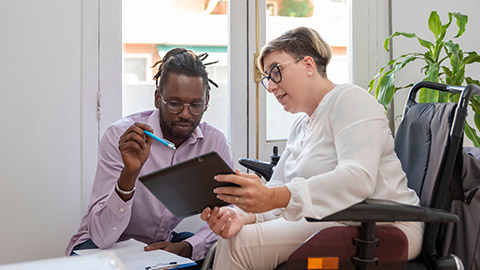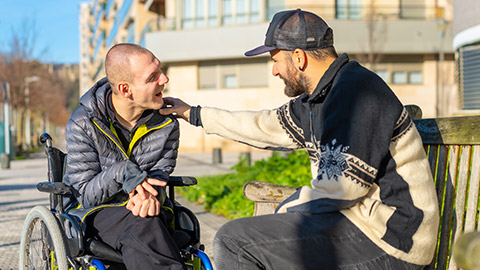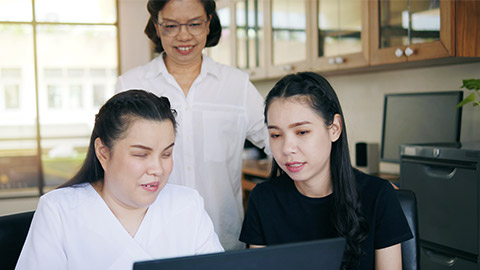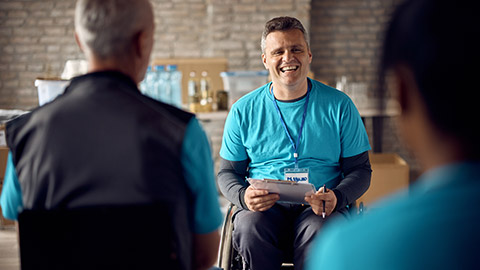Barriers still exist to community participation and social inclusion for people with disability, so it will be important for you to be able to identify these barriers, understand how they have an impact on your clients and work with your clients on how to address and overcome them.
When identifying, addressing, and monitoring barriers to community participation and social inclusion when working as a support worker for people with disabilities it is important to:
- Listen
- Observe
- Engage
- Check-in
You can begin by actively engaging with individuals with disabilities and their support networks to identify barriers they face in community participation and social inclusion. This may involve:
- Conducting assessments
- Listening to their experiences
- Observing their interactions
Recognise, Engage and Check-In
It is important that you are able to recognise that each person has unique needs and preferences, and tailor your support accordingly. Work closely with individuals to understand their goals, interests, and challenges. Collaboratively develop strategies that support their specific requirements and preferences. This may involve assisting with transportation arrangements, connecting them with community groups or organisations, providing communication support, or facilitating social opportunities to enhance their participation and inclusion. Continuously monitor the effectiveness of the strategies implemented to address barriers.
Regularly check in with individuals to assess their experiences, challenges, and successes in community participation. Seek feedback from them and their support networks to understand the impact of the support provided. Adjust strategies as needed based on their feedback and changing circumstances. By maintaining open communication and a proactive approach to monitoring, you can continuously improve and ensure individuals' needs are met effectively. Note: When promoting community participation and social inclusion requires a person-centered approach, active collaboration, and ongoing evaluation. By identifying barriers, addressing them through targeted strategies, providing individualised support, and monitoring progress, you can help individuals with disabilities overcome obstacles and actively engage in their communities.
Read
Epic Assist: The biggest barrier for people with disability is how society disables them
United Nations: Breaking down barriers
Watch
Talking about breaking down barriers for people with disability
Communication and Active listening
Communication is a critical factor when working with clients.
Active listening skills are paramount when working with people with disabilities because effective communication is the cornerstone of building trust, understanding, and empowerment.
By actively listening to individuals with disabilities, support workers demonstrate genuine interest and respect for their thoughts and experiences. This validation fosters a safe and inclusive environment where the person feels heard and valued, enabling them to express their needs, preferences, and concerns more openly. Additionally, active listening allows support workers to gain deeper insights into the person's unique challenges and aspirations, facilitating the development of personalized support plans that address their individual needs effectively.
Furthermore, active listening skills help bridge potential communication gaps that may arise due to the person's disability. Support workers who actively listen are better equipped to interpret non-verbal cues, such as body language or facial expressions, and adapt their communication style accordingly. This adaptability promotes smoother interactions and enables the person to communicate more comfortably.
Active listening also helps identify any barriers the person may face in accessing services or participating in activities, leading to more inclusive and supportive practices that ensure equal opportunities for individuals with disabilities. Overall, active listening is a fundamental tool that enhances the support worker's ability to provide person-centered care, nurture positive relationships, and promote the overall well-being and empowerment of people with disabilities.
Read
Open this resource from the PWDA (People with Disability Australia) that provides best practice advice to support all people, when talking about or reporting on disability:
Watch
How can I communicate better with people with learning disabilities

Barrier types to community participation and social inclusion
There are a range of barriers that are faced by individuals with disabilities including:
Physical Barriers which refer to obstacles in the physical environment that limit access for individuals with disabilities. Examples include:
- Inaccessible buildings
- Lack of ramps or elevators
- Narrow doorways
- Inadequate signage.
Attitudinal Barriers which can include:
- Negative attitudes
- Stereotypes
- Misconception
- Stigma
These barriers can lead to discrimination, prejudice, and exclusion from social interactions and opportunities.
Communication barriers which can occur when individuals with disabilities face difficulties in effective communication. This can be due to speech or language impairments, hearing loss, or lack of accessible communication methods, such as sign language interpretation or alternative communication devices. We communicate with people many times every day, either face to face, on the phone or in writing. When communicating with someone with disability, it is important to remember to treat each person as an individual. Also, treat people with respect and consideration and in the way that you would want to be treated.
Read
This resource has some great information about communicating with people with disabilities:
QLD Health: Better communication
Watch
How miscommunication happens
Other barriers can include:
- Social and Cultural Barriers that can stem from societal norms, biases, or exclusionary practices. These barriers can manifest as a lack of inclusive social activities, limited opportunities for participation, or cultural practices that do not accommodate diverse needs and abilities.
- Policy and legal barriers which refer to laws, regulations, or policies that impede equal access and inclusion for individuals with disabilities. These barriers can include limited accessibility requirements, inadequate funding for support services, or discriminatory policies that hinder participation in education, employment, or community programs.
- Economic barriers which can arise when financial constraints limit opportunities for individuals with disabilities. This can include limited employment opportunities, lack of accessible transportation options, or inability to afford necessary assistive devices or accommodations.
- Knowledge and awareness barriers that can occur when there is a lack of understanding or awareness about disabilities and the specific needs of individuals. This can result in limited knowledge among service providers, community members, or employers, leading to exclusion and inadequate support.
Read
UDS Foundation:Overcoming social barriers for persons with disabilities
Watch
'What we wish people knew about living with a disability' | IDPwD | ABC Australia

Consultation is a key factor when identifying gaps in assistive technology needs for an individual. Some aspects you will need to consider are to:
- Build a trusting and respectful relationship with the person to create an environment where they feel comfortable expressing their needs, preferences, and challenges related to assistive technology.
- Engage in active listening and observe the person's daily activities, interactions, and tasks to identify areas where they may face difficulties or where existing assistive technologies may not adequately meet their needs.
- Use questioning techniques or observing an individual to gather information about the person's specific functional limitations, goals, and activities they would like to perform independently. For example, opened and closed questions.
Watch
Questioning Techniques
Collaboration
- With consent, collaborate with healthcare professionals or assistive technology specialists for their insights and expertise. With the person, determine the assistive technologies the person is currently using and discuss their experiences with them. Assess the effectiveness, limitations, and areas for improvement of the existing technologies based on their feedback.
- Engage in collaborative goal setting with the person to set goals that align with their needs, preferences, and aspirations. These goals can be related to improving independence, communication, mobility, education, employment, or other areas where assistive technology can enhance their quality of life. Based on the needs assessment and goal setting, identify any gaps or areas where current assistive technologies fall short in meeting the person's needs. This can include specific functionalities, accessibility features, compatibility concerns, or usability issues.
- Research available assistive technologies and consult with your Supervisor or assistive technology specialists, occupational therapists, or rehabilitation engineers. Seek their input and expertise to identify potential solutions that address the identified gaps and meet the person's needs effectively.
- Facilitate trials or demos of potential assistive technologies with the person, allowing them to test and provide feedback. Evaluate the usability, effectiveness, and compatibility of these technologies in addressing their identified gaps and meeting their goals.
Remember throughout the process to always, involve the person in the decision-making process, you can effectively consult with them to identify gaps in assistive technology needs. This collaborative approach ensures that the chosen technologies address their unique requirements and enhance their independence and overall well-being and always ensure you comply with your organisational policies and procedures.
Watch
Bridging the Gap with Assistive Technology: How to Reduce Learning Loss in Online Learning
Watch
Jane Velkovski: The life-changing power of assistive technologies | TED

As a support worker working with people with disabilities, collaboration with the individual to identify solutions and overcome barriers is essential.
You should involve the person by establishing open communication and building rapport with the individual by actively listening to their needs, concerns, and goals. Create an environment that encourages open dialogue and mutual respect.
Work together to identify the specific barriers the person faces in their daily life. This could include physical, social, or emotional challenges that hinder their independence or participation.
Assess the person's abilities, strengths, and areas for improvement. This can be done through discussions, observations, and involving relevant professionals if necessary. Collaborate with the individual to generate potential solutions for addressing the identified barriers. Encourage their active participation and ensure their preferences, choices, and goals are respected.
Discuss the proposed solutions and their feasibility with your supervisor. They can provide valuable insights, guidance, and support based on their expertise and experience. Evaluate and prioritise solutions: Assess the potential impact and feasibility of each solution. Prioritise based on the person's preferences, available resources, and desired outcomes.
Create an action plan together that outlines the steps needed to implement the chosen solutions. Include timelines, responsibilities, and measurable goals. Implement and monitor progress: Execute the action plan while providing ongoing support. Regularly monitor progress, address challenges, and make necessary adjustments to the plan.
Keep clear records of the process, including barriers, proposed solutions, action plans, and progress. Share relevant information with your supervisor and other professionals involved in the person's care. Remember, the collaboration process should be person-centered, empowering the individual to make informed choices. Your role as a support worker is to facilitate their journey by providing guidance and assistance.
Watch
What Ability helping ‘break down barriers’ with disability support services

To support the person in implementing strategies to address barriers to community participation according to their individualised plan and preferences, you should consider the following information:
- Familiarise yourself with the person's plan, which outlines their goals, preferences, and strategies for community participation. Understand the specific barriers they face and the strategies already identified.
- Discuss implementation strategies by engaging in discussions to understand the person's comfort level and preferences regarding the strategies. Collaboratively explore different approaches to overcome barriers and enhance community participation.
- Offer assistance in implementing the strategies outlined in their plan. This may involve demonstrating skills, providing resources or information, or connecting them with relevant community services or organisations.
- Remain flexible and open to adjusting the strategies based on feedback and evolving needs. Regularly assess the effectiveness of the implemented strategies and make necessary modifications.
- Empower the person to advocate for themselves in the community. Provide them with information and tools to communicate their needs and rights effectively. Offer ongoing encouragement and motivation: Be a source of encouragement and motivation as they work towards overcoming barriers. Recognise their achievements and celebrate their successes.
- Engage with community organisations, service providers, and stakeholders to enhance community participation. Establish partnerships and seek support when needed, ensuring the person's needs and preferences are considered.
- Regularly monitor their progress in implementing strategies. Assess the effectiveness of the strategies in achieving their desired outcomes. Reassess the plan as necessary, making adjustments to better align with their evolving needs and aspirations.
Important note: Remember, personalised support (person centred planning) and fostering autonomy are crucial to helping the person overcome barriers and actively participate in their community.
Read
NDS: Community Participation in Action
La Trobe University: Effective Programs to Support Community Participation
ShiftCare: Everything you need to include in individualised care plans, plus examples
Watch
What is person centred planning?

It is important to consult with a person with a disability and identify areas where advocacy is needed because it ensures their voice is heard and respected in decisions that affect their life. By involving them in the process, their unique experiences and needs can be addressed, leading to more effective advocacy efforts. This consultation promotes empowerment, personalised support, and social inclusion for individuals with disabilities.
To consult with a person with a disability and identify areas where advocacy is required to facilitate their preferred manner of participation it is important to:
- Build a trusting relationship with the person by creating a safe and supportive environment. Ensure they feel comfortable sharing their thoughts, concerns, and aspirations.
- Practice active listening to understand the person's experiences, needs, and desires regarding their participation. Encourage open communication and provide opportunities for them to express their preferences.
- Engage in discussions to identify any barriers or challenges that may hinder their preferred manner of participation. These barriers can be physical, attitudinal, systemic, or related to communication or accessibility.
- Talk about the concept of advocacy and its potential benefits for the person. Explain how advocacy can help address barriers and promote their preferred manner of participation. Share examples of successful advocacy efforts in similar situations.
- Collaborate with the person to determine their specific goals and desired manner of participation. Understand their preferences regarding accommodations, support, communication styles, and any other factors that can enhance their participation.
- Assess the person's needs by considering their abilities, strengths, and areas where they require support or accommodations to facilitate their preferred manner of participation. Involve relevant professionals, such as occupational therapists or accessibility experts, if necessary.
- Identify potential advocacy strategies that align with the person's goals and preferences. These may include requesting reasonable accommodations, addressing discrimination, promoting accessibility, or influencing policy changes.
- Encourage the person to develop self-advocacy skills so they can effectively communicate their needs and preferences. Provide guidance on assertiveness, self-expression, and understanding their rights.
- Work together with the person to prioritise the identified areas where advocacy is required. Discuss the potential strategies and select the most appropriate ones based on the person's comfort level, goals, and available resources.
- Connect with organisations, advocacy groups, disability service providers, or community members who can support the advocacy efforts. Collaborate with these stakeholders to promote the person's preferred manner of participation and address the identified barriers.
- Follow up and monitor progress: Regularly check in with the person to assess the progress of advocacy efforts. Provide ongoing support, celebrate successes, and address any challenges that arise. Modify strategies if needed to ensure the person's preferred manner of participation is facilitated effectively.
Consulting with a person with a disability is essential because it respects their autonomy, ensures their needs and preferences are heard, and empowers them to actively participate in shaping their own lives. It is a fundamental step in effective advocacy that promotes inclusivity, equality, and dignity for all individuals with disabilities.
Systematic Advocacy
Systematic advocacy refers to a strategic and organized approach to promoting positive change and advancing the rights of a particular group or community. Instead of addressing isolated incidents, systematic advocacy focuses on identifying broader patterns of discrimination or systemic barriers that hinder equal opportunities. By collecting data, conducting research, and collaborating with various stakeholders, advocates work towards influencing policies, laws, and practices that can lead to long-lasting, systemic improvements for the targeted group. This approach aims to create sustainable change that benefits not only individuals but the entire community, promoting inclusivity and social justice on a larger scale.
Case Study
A group of disability advocates in their local community noticed a lack of accessibility for people with mobility impairments at the two (2) train stations in their town. They observed that many stations did not have wheelchair ramps, making it challenging for individuals with mobility challenges to use public transport conveniently. The advocates decided to take a systematic approach to address this issue. They gathered data and evidence from various sources, showing that the lack of accessibility posed a significant barrier to the disabled community's mobility and inclusion. Collaborating with disability organisations, experts, and local government officials, they raised awareness about the problem and advocated for change. Their efforts paid off when they successfully influenced the city's transportation authorities to invest in accessibility improvements. As a result, the train stations in their local community were equipped with wheelchair ramps, and accessible buses were introduced to ensure a more inclusive transportation system. This systematic advocacy not only improved the lives of individuals with disabilities but also enhanced the overall accessibility and inclusivity of the entire city's public transportation for everyone.
Individual Advocacy
Individual advocacy refers to the personalized support provided to a specific person, ensuring their rights are upheld and their voice is heard. Advocates work closely with the individual to understand their needs, preferences, and concerns. They help the person navigate systems, access services, and make informed decisions, ensuring their well-being and rights are protected. Individual advocacy focuses on empowering the person to express their wishes and choices, while the advocate serves as a supportive ally, helping them achieve their goals and navigate any challenges they may encounter. For instance, suppose an individual with a disability faces difficulties accessing appropriate healthcare services. An individual advocate would work closely with the person, understanding their specific healthcare needs and preferences. They might provide information about available healthcare options, accompany the person to medical appointments, and ensure their concerns are communicated effectively to healthcare providers. The advocate would advocate for the person's rights and preferences, making sure they receive the necessary support and care to improve their health outcomes. Individual advocacy aims to empower the person, promote their independence, and ensure their unique needs and desires are respected and met.
Case Study: Meet Jennifer
Jennifer is young girl with a hearing impairment, who loves learning but faces challenges in accessing education. Sarah's parents are concerned about her educational needs not being fully met at her local school due to a lack of inclusive practices and accommodations. To address this, an individual advocate named Alex steps in to support Sarah and her family. Alex meets with Sarah and her parents to understand her specific educational needs and goals. Through active listening, Alex learns that Sarah prefers using sign language to communicate and requires access to assistive technologies in the classroom. With this valuable information, Alex collaborates with the school administration, teachers, and educators to advocate for Sarah's rights to an inclusive education. They provide training to teachers on effective communication strategies and introduce sign language interpretation during class sessions. Alex also works with the school to secure funding for assistive devices, ensuring Sarah can fully participate in classroom activities. As a result of Alex's advocacy, Sarah's educational experience significantly improves. She feels more included, engaged, and confident in her learning journey. With the necessary support and accommodations, Sarah thrives academically and socially, proving that individual advocacy can make a remarkable difference in the life of a young learner with special needs.
Read
Voices Together: Support Workers Training Tool Kit: What is Self-Advocacy
Australian Government: National Disability Advocacy Program and Disability advocacy for individuals fact sheet
ADA Australia: Disability Advocacy
Watch
Disability Advocacy 101?
Watch
Disability Advocacy and the NDIS - Honi Brasher

Monitoring the success of strategies to address barriers in consultation with the person and supervisor is important as it allows for ongoing evaluation and adjustment of interventions to ensure their effectiveness. It ensures that the strategies align with the person's evolving needs and preferences, leading to improved outcomes and a person-centered approach. Regular monitoring also promotes collaboration and accountability between the person, support worker, and supervisor, fostering a holistic and effective support system.
To monitor the success of strategies to address barriers in consultation with the person and supervisor, read the following strategies:
- Define specific indicators or measurable outcomes that reflect the success of the strategies implemented. These indicators should align with the goals and objectives identified during the initial consultation.
- Schedule regular check-in meetings or discussions with the person to evaluate their progress and gather feedback. Seek their input on how the strategies are working for them, what challenges they may be facing, and any adjustments they suggest.
- Collect data to assess the effectiveness of the strategies. This can include direct observations, interviews, surveys, and any relevant documentation or records.
- Analyse the collected data to assess the impact of the strategies on addressing the identified barriers. Look for trends, patterns, and key insights that indicate success or areas that may require further attention.
- Reflect on how the strategies have contributed to the person's overall well-being, independence, and quality of life. Consider their level of satisfaction, increased participation in desired activities, and improvements in their overall functioning and empowerment. Based on the evaluation and feedback received, make necessary modifications and adaptations to the strategies. This can include refining existing approaches, exploring new alternatives, or seeking additional support or resources as required.
- Maintain open lines of communication and ongoing collaboration with the person and supervisor.
- Regularly share updates, seek their input, and ensure that any adjustments or changes to the strategies are understood and agreed upon.
- Keep detailed records of the monitoring process, including the data collected, decisions made, and outcomes observed. This documentation will help track progress over time, inform future strategies, and provide evidence of the effectiveness of the implemented approaches.
By monitoring the success of strategies in consultation with the person and supervisor, you ensure that the interventions remain person-centered, effective, and responsive to the individual's needs and goals. Regular evaluation and collaboration allow for ongoing improvements and adjustments to achieve the desired outcomes and overcome barriers effectively.
Read
QLD Government: Ways to evaluate measures
Centre for Universal Design Australia: Monitoring and Evaluation in Disability Inclusiveness

Recognising one's limitations in addressing issues and seeking advice from a supervisor is important to ensure quality, safety, and professional growth. It prevents potential errors or risks that may arise from exceeding one's expertise and allows for learning and acquiring new skills. Seeking guidance fosters collaboration and teamwork, tapping into collective wisdom and resources for informed decision-making.
Some factors to consider when recognising your own limitations in addressing issues are:
- Recognising and acknowledging one's limitations helps prevent potential errors, risks, or harm that may arise from attempting to address issues beyond one's expertise.
- Seeking advice from a supervisor ensures that appropriate actions are taken by someone with the necessary knowledge and authority, promoting quality and safety in the support provided.
- Acknowledging limitations creates opportunities for personal and professional growth. Seeking guidance from a supervisor allows for learning from their experience and expertise, enabling the acquisition of new skills and knowledge that can expand one's abilities and enhance job performance. Seeking advice from a supervisor fosters a culture of collaboration and teamwork. It demonstrates an understanding that effective problem-solving often requires input and collaboration from multiple perspectives.
Consulting with a supervisor helps tap into the collective wisdom and resources available within the organisation, leading to more comprehensive and informed decision-making. By recognising and respecting one's limitations and seeking advice from a supervisor, support workers can provide the best possible care and support to individuals with disabilities, ensuring their well-being and promoting professional development within their role.
Building Boundaries
Boundaries are very important when working as a disability support worker for several reasons. Firstly, they help maintain a professional relationship with the person with a disability, ensuring that interactions focus on effective support without becoming personal. Secondly, boundaries respect the person's privacy and dignity, making sure that sensitive information is kept confidential. This also encourages the person to be more independent and make their own decisions, promoting their autonomy and self-reliance. Lastly, setting clear boundaries prevents support workers from experiencing burnout and helps establish trust with the person, as they feel safe and respected in the support relationship. Overall, boundaries are crucial for providing ethical and effective support to individuals with disabilities.
It is important to remember that everyone will bring a variety of strengths, skills, values, beliefs and practical knowledge to their roles as support workers and that you are bound by your organisations workplace policies and procedures, e.g. Code of Conduct, Code of Ethics, Role Description etc.
When working with clients, always remember to:
- Set clear expectations
- Be clear about your role and its limitations
- Keep your relationship professional
- Avoid disclosing your personal information
- Maintain your clients privacy and confidentiality
Read
Alden Mills: How important is it to know your limitations
QLD Health: Building good boundaries in support work
Watch
Setting health boundaries
